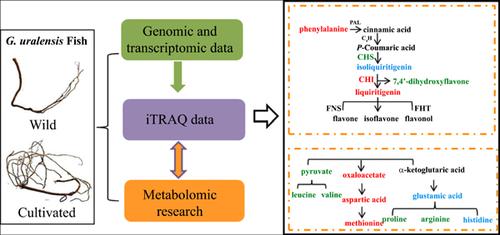Current Proteomics ( IF 0.8 ) Pub Date : 2020-09-30 , DOI: 10.2174/1570164617666191004114511 Chengcheng Wang 1 , Lihong Chen 1 , Zhichen Cai 1 , Sijing Feng 1 , Moyi Yue 1 , Jiaojiao Yang 1 , Lisi Zou 1 , Xunhong Liu 1

|
Background: Licorice is an herbal medicine applied extensively worldwide, and most of the licorice for clinical consumption is provided by Glycyrrhiza uralensis Fisch. Evidence suggests that there is a significant difference in the metabolite composition of licorice from different ecotypes.
Objective: To better understand the proteomic changes and molecular mechanisms of metabolite formation in wild and cultivated Glycyrrhiza uralensis Fisch.
Methods: Firstly, we established a proteome database by annotating protein sequences according to the genomic and transcriptomic data of G. uralensis. Then, iTRAQ and LC-MS/MS were applied to detect significant protein changes between cultivated and wild G. uralensis. A total of 2751 validated proteins were obtained with high confidence, and 333 were differentially expressed. Differentially expressed proteins were identified and analysed by GO, KEGG, and STRING for network and pathway enrichment. Ultimately, we combined the iTRAQ results with our previous investigation on metabolites to understand the molecular mechanisms underlying metabolite accumulation.
Results: The results showed that differentially expressed proteins were mainly involved in the anabolism of carbohydrates and important amino acids that participate in primary metabolism and secondary metabolite synthesis. Another important pathway is the synthesis of flavonoids, which are generally accepted as important bioactive constituents of G. uralensis, and the accumulation of flavonoids in different synthesis stages in two ecotypes of G. uralensis was diverse. Therefore, the differentially abundant proteins in wild and cultivated G. uralensis possibly resulted in differences in medicinal compounds.
Conclusion: Our study will provide novel clues for revealing the molecular mechanism of secondary metabolite synthesis as well as quality formation in wild and cultivated G. uralensis.
中文翻译:

比较iTRAQ蛋白质组学分析提供了栽培甘草及其野生型代谢物的分子基础
背景:甘草是一种在世界范围内广泛应用的草药,临床上消费的大多数甘草是由甘草甘草提供的。有证据表明,来自不同生态类型的甘草的代谢产物组成存在显着差异。
目的:更好地了解野生和栽培的甘草中蛋白质的蛋白质组学变化及其代谢产物的分子机制。
方法:首先,根据甘草的基因组和转录组数据,通过注释蛋白质序列建立蛋白质组数据库。然后,iTRAQ和LC-MS / MS被用于检测栽培和野生甘草之间蛋白质的显着变化。总共获得了2751个经过验证的蛋白质,并且有333个差异表达。通过GO,KEGG和STRING鉴定并分析差异表达的蛋白质,以进行网络和途径富集。最终,我们将iTRAQ结果与我们先前对代谢物的研究相结合,以了解代谢物蓄积的分子机制。
结果:结果表明差异表达的蛋白质主要参与碳水化合物和重要氨基酸的合成代谢,这些碳水化合物和氨基酸主要参与初级代谢和次级代谢产物的合成。另一个重要途径是黄酮类化合物的合成,黄酮类化合物通常被认为是G.uralensis的重要生物活性成分,并且在两种生态型的G.uralensis中,黄酮类化合物在不同合成阶段的积累是不同的。因此,野生和栽培的G.uralensis中差异丰富的蛋白质可能导致药用化合物的差异。
结论:我们的研究将为揭示野生和栽培的甘草的次生代谢产物合成的分子机制以及质量形成提供新的线索。



























 京公网安备 11010802027423号
京公网安备 11010802027423号